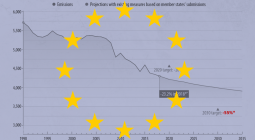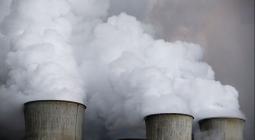2024 lookahead: Climate target for 2040 will be EU Commission’s ‘legacy’, activists say
The European Commission is expected to table its proposed climate target for 2040 on 6 February, in what many see as the current administration’s legacy for the new team that will be appointed to lead the Brussels-based executive after the June EU elections.
The EU’s appropriate level of ambition for 2040 was at the centre of debate when lawmakers in the European Parliament voted to approve the EU’s new Commissioner for Climate Action, Wopke Hoekstra, back in October.
Under pressure from MEPs, Hoekstra pledged to defend a 90% reduction in net greenhouse gas emissions by 2040, in line with advice from the European Scientific Advisory Board on Climate Change, which recommended a reduction of 90-95%.
For the environmental campaign group Carbon Market Watch, the 2040 target plan represents the last opportunity for the Commission to leave a legacy in the fight against climate change.
“We support the adoption of a legally-binding target to reduce gross emissions by more than 90% compared to 1990,” says Sam Van den Plas, policy director at Carbon Market Watch.
However, Van den Plas also made it clear that environmental groups were expecting the EU to adopt a much higher level of ambition, in line with the objectives of the Paris Agreement.
“We would prefer to see a net-zero emissions target for 2040,” he told Euractiv, a position which is backed by other environmental groups like the WWF.
“WWF’s position is that the EU should aim to reach climate neutrality – a 100% reduction in net GHG emissions – by 2040, and to cut emissions by 2030 by 65%,” the conservation group said.
Pascal Canfin, the chair of the European Parliament’s environment committee, also supports a high target for 2040.
According to him, the pace of emission cuts set for 2020 and 2030 (-20% and -55% compared to 1990 levels) already puts the EU on a trajectory to achieve a 90% cut in emissions by 2040.
“If we make the same effort between 2030 and 2040, we will reach -90%,” he told Euractiv in a recent interview.
Canfin also pointed to the Paris Agreement, which says emissions in rich countries must be reduced to net zero by 2050 “at the latest”, suggesting a 2045 deadline would be preferable to keep in line with the EU’s commitments.
“According to the International Energy Agency (IEA), Europe should reach net zero by 2045,” the French MEP said.
Carbon removals
Another key issue in the 2040 target debate is the share of emission cuts that can be expected from carbon removals achieved from nature-based solutions like forests and nature conservation.
According to Carbon Market Watch, a clear distinction must be made, with separate targets for emissions reductions, carbon removals from land use and forestry (LULUCF), and those achieved by technological means like Direct Air Capture (DAC).
“We strongly recommend separating emission reductions from technological carbon removals and LULUCF targets,” Carbon Market Watch says in its contribution to the Commission’s 2040 target plan.
In this context, Van den Plas notes that the Commission will also present a communication on an “industrial carbon management plan” on 6 February, with the aim of developing carbon capture and storage technologies to abate emissions from heavy industries.
“Carbon removal has a role to play, but if the policy focuses only on offsetting for heavy industries, there’s a risk that we’ll continue to produce greenhouse gas emissions,” Van den Plas warns.
Crucially, activists say carbon removal credits must be excluded from trading under the EU’s carbon market, the Emissions Trading Scheme, in order to maintain pressure on polluters to decarbonise.
“Carbon markets are inherently unsuitable for carbon removals because quality is the key concern, not price,” CMW argues.
Doing so would also risk undermining the EU’s carbon market because it would “send a signal to market participants that the EU ETS cap will not be binding in the future,” it warns.
Rather, “a separate target for these removals should be established based on a robust assessment of the sustainability and potential impact of these activities,” CMW argues.
Avoiding deindustrialisation
European industries, for their part, say they support the EU’s climate objectives but warn that decarbonisation policies must also preserve their competitiveness relative to companies outside of Europe.
“A 90% headline target for the entire EU society entails almost a full decarbonisation of energy intensive industries such as steel,” says the European Steel Association, Eurofer.
“This is possible only if there is the certainty of having access to competitive clean energy in unprecedented quantities, while levelling the playing field with other regions of the world that do not share the same climate ambition,” Eurofer adds, noting that decarbonising the EU steel industry alone “would require the equivalent of Germany’s current electricity consumption.”
The European Chemical Industry Council (CEFIC) agrees. In its contribution to the EU’s 2040 climate target debate, it says “solid funding solutions” must be available to support low-carbon investments, alongside greater “availability and accessibility to low-carbon and renewable energy”.
CEFIC’s fear is that the combination of high energy prices, rising carbon costs and lack of financial support from governments will push chemical companies to locate new factories outside of the EU, where production costs are usually lower.
“Europe’s efforts to reduce industrial emissions should not lead to the delocalisation of parts of vital industrial value chains,” CEFIC warns.
Eurofer argues along the same line, saying “climate ambition must be achieved through innovation and investment in Europe rather than through deindustrialisation”.
Next steps
The EU’s 27 environment ministers will have an opportunity to discuss the 2040 target plan when they gather on 16 January for the first informal Environment Council held under the Belgian Presidency of the EU.
After the Commission tables its proposal on 6 February, a formal exchange will then take place at the Environment Council on 25 March.
EU heads of state will then have an opportunity to weigh in on the debate at a summit on 27-28 June as part of the EU’s Strategic Agenda for 2024-2029, which will set the EU’s priorities for the new institutional cycle after the June EU elections.
Cover photo: Eurofer explains that "decarbonising the EU steel industry alone would require the equivalent of Germany's current electricity consumption." [Photo credit: EUROPEAN COMMISSION/Ryan LIM]





